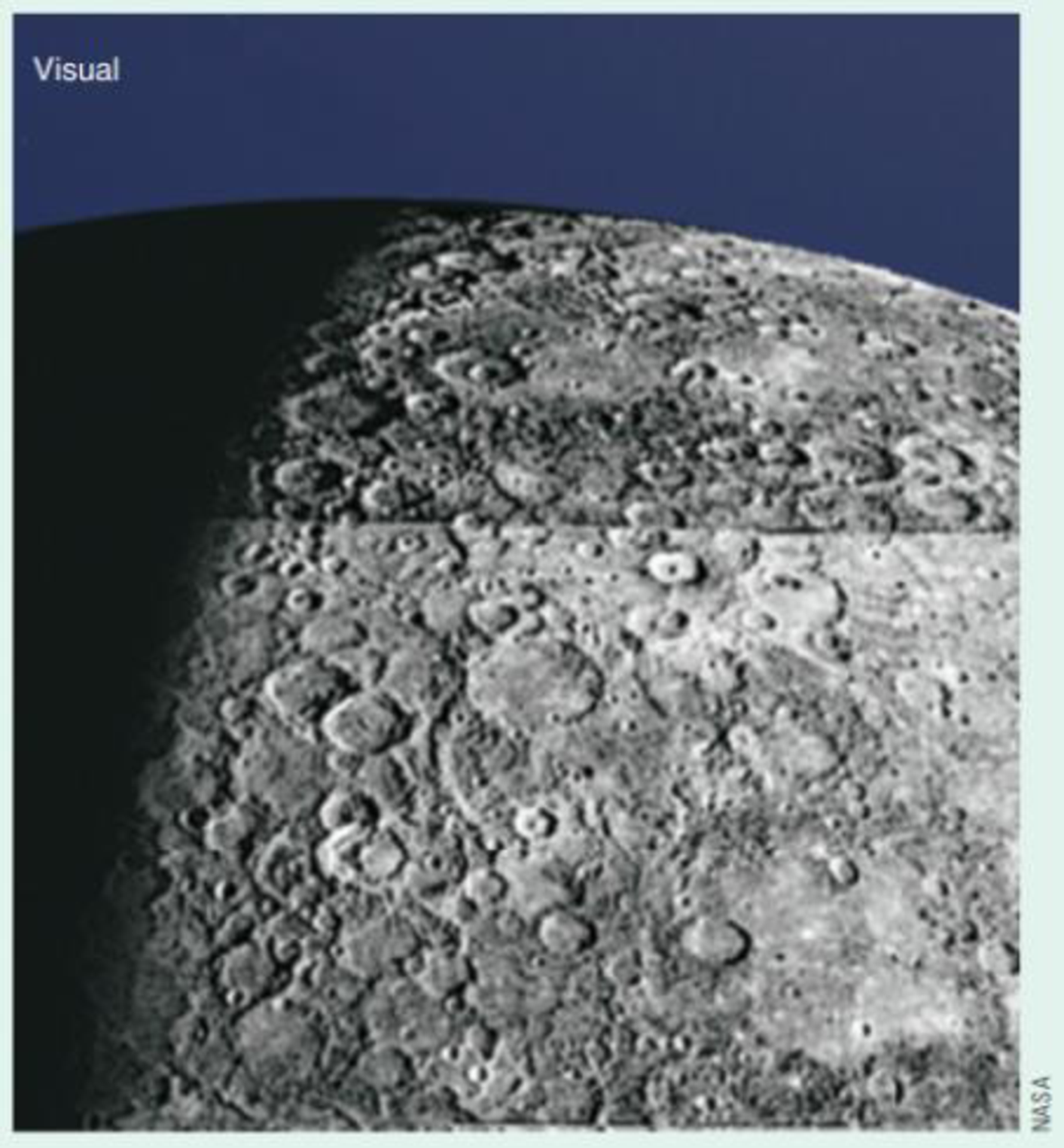
Mindtap Astronomy, 1 Term (6 Months) Printed Access Card For Seeds/backman's Foundations Of Astronomy, 14th
14th Edition
ISBN: 9781337399975
Author: Michael A. Seeds, Dana Backman
Publisher: Cengage Learning
expand_more
expand_more
format_list_bulleted
Textbook Question
Chapter 18, Problem 2LTL
Why do astronomers conclude that the surface of Mercury, shown here, is old? When did the majority of those craters form?

Expert Solution & Answer
Trending nowThis is a popular solution!

Students have asked these similar questions
A 0.500 kg sphere moving with a velocity given by (2.00î – 2.60ĵ + 1.00k) m/s strikes another sphere of mass 1.50 kg moving with an initial velocity of (−1.00î + 2.00ĵ – 3.20k) m/s.
(a) The velocity of the 0.500 kg sphere after the collision is (-0.90î + 3.00ĵ − 8.00k) m/s. Find the final velocity of the 1.50 kg sphere.
R =
m/s
Identify the kind of collision (elastic, inelastic, or perfectly inelastic).
○ elastic
O inelastic
O perfectly inelastic
(b) Now assume the velocity of the 0.500 kg sphere after the collision is (-0.250 + 0.850ĵ - 2.15k) m/s. Find the final velocity of the 1.50 kg sphere.
✓ =
m/s
Identify the kind of collision.
O elastic
O inelastic
O perfectly inelastic
(c) Take the velocity of the 0.500 kg sphere after the collision as (−1.00ỉ + 3.40] + ak) m/s. Find the value of a and the velocity of the 1.50 kg sphere after an elastic collision. (Two values of a are possible, a positive value and a negative value. Report each with their
corresponding final velocities.)
a…
A cannon is rigidly attached to a carriage, which can move along horizontal rails, but is connected to a post by a large spring, initially unstretched and with force constant k = 1.31 x 104 N/m, as in the figure below. The cannon fires a 200-kg projectile at a velocity of 136 m/s directed 45.0°
above the horizontal.
45.0°
(a) If the mass of the cannon and its carriage is 5000 kg, find the recoil speed of the cannon.
m/s
(b) Determine the maximum extension of the spring.
m
(c) Find the maximum force the spring exerts on the carriage. (Enter the magnitude of the force.)
N
launch angle.
Passage Problems
Alice (A), Bob (B), and Carrie (C) all start from their dorm and head
for the library for an evening study session. Alice takes a straight path,
Chapter 18 Solutions
Mindtap Astronomy, 1 Term (6 Months) Printed Access Card For Seeds/backman's Foundations Of Astronomy, 14th
Ch. 18 - Why was the nebular hypothesis never fully...Ch. 18 - What produced the helium now present in the Suns...Ch. 18 - What produced the iron and heavier elements such...Ch. 18 - Prob. 4RQCh. 18 - What evidence can you give that disks of gas and...Ch. 18 - Why is the solar nebula theory considered a theory...Ch. 18 - According to the solar nebula theory, why is...Ch. 18 - According to the solar nebula theory, why is there...Ch. 18 - Why does the solar nebula theory predict that...Ch. 18 - What evidence can you give that the Solar System...
Ch. 18 - What planet in the Solar System is larger than the...Ch. 18 - Why is almost every solid surface in the Solar...Ch. 18 - What is the difference between condensation and...Ch. 18 - Why dont Terrestrial planets have ring systems...Ch. 18 - How does the solar nebula theory help you...Ch. 18 - Prob. 16RQCh. 18 - If rocks obtained from the Moon indicate an age of...Ch. 18 - Which is older, the Moon or the Sun? How do you...Ch. 18 - How does the solar nebula theory explain the...Ch. 18 - Did hydrogen gas condense from the nebula as the...Ch. 18 - What happens if a planet has differentiated? Would...Ch. 18 - Order the following steps in the formation of a...Ch. 18 - Which step(s) listed in the previous question can...Ch. 18 - Describe two processes that could melt the...Ch. 18 - What is the evidence that Jupiter and Saturn are...Ch. 18 - Describe two processes that cleared the solar...Ch. 18 - What is the difference between a planetesimal and...Ch. 18 - Does Uranus have enough mass to have formed by...Ch. 18 - What properties of the gas and dust disks observed...Ch. 18 - Why would the astronomically short lifetime of gas...Ch. 18 - Prob. 31RQCh. 18 - Describe three methods to find extrasolar planets.Ch. 18 - Why is the existence of hot Jupiters puzzling?...Ch. 18 - The evidence is overwhelming that the Grand Canyon...Ch. 18 - Prob. 35RQCh. 18 - If you observed the Solar System from the vantage...Ch. 18 - Venus can be as bright as apparent magnitude 4.7...Ch. 18 - What is the smallest-diameter crater you can...Ch. 18 - Prob. 4PCh. 18 - Prob. 5PCh. 18 - You analyze a sample of a meteorite that landed on...Ch. 18 - You analyze a sample of a meteorite that landed on...Ch. 18 - Prob. 8PCh. 18 - Examine Table 18-2. What might a planets...Ch. 18 - Examine Table 18-2. What might a planets...Ch. 18 - Suppose that Earth grew to its present size in 10...Ch. 18 - Prob. 12PCh. 18 - Prob. 13PCh. 18 - Prob. 1SOPCh. 18 - Prob. 2SOPCh. 18 - What do you see in this image that indicates this...Ch. 18 - Why do astronomers conclude that the surface of...Ch. 18 - Prob. 3LTLCh. 18 - Prob. 4LTL
Knowledge Booster
Learn more about
Need a deep-dive on the concept behind this application? Look no further. Learn more about this topic, physics and related others by exploring similar questions and additional content below.Similar questions
- below the horizontal, and land 55 m horizontally from the end of the jump. Your job is to specify the slope of the ground so skiers' trajectories make an angle of only 3.0° with the ground on land- ing, ensuring their safety. What slope do you specify? T 9.5° -55 marrow_forwardMake sure to draw a sketch and a free body diagram. DO NOT give me examples but ONLY the solutionarrow_forwardMake sure to draw a sketch AND draw a Free body diagramarrow_forward
- P -3 ft 3 ft. O A B 1.5 ft Do 1.5 ft ✓ For the frame and loading shown, determine the magnitude of the reaction at C (in lb) if P = 55 lb. (Hint: Use the special cases: Two-force body and Three-force body.)arrow_forwardA convex mirror (f.=-6.20cm) and a concave minor (f2=8.10 cm) distance of 15.5cm are facing each other and are separated by a An object is placed between the mirrors and is 7.8cm from each mirror. Consider the light from the object that reflects first from the convex mirror and then from the concave mirror. What is the distance of the image (dia) produced by the concave mirror? cm.arrow_forwardAn amusement park spherical mirror shows park spherical mirror shows anyone who stands 2.80m in front of it an upright image one and a half times the person's height. What is the focal length of the minor? m.arrow_forward
- An m = 69.0-kg person running at an initial speed of v = 4.50 m/s jumps onto an M = 138-kg cart initially at rest (figure below). The person slides on the cart's top surface and finally comes to rest relative to the cart. The coefficient of kinetic friction between the person and the cart is 0.440. Friction between the cart and ground can be ignored. (Let the positive direction be to the right.) m M (a) Find the final velocity of the person and cart relative to the ground. (Indicate the direction with the sign of your answer.) m/s (b) Find the friction force acting on the person while he is sliding across the top surface of the cart. (Indicate the direction with the sign of your answer.) N (c) How long does the friction force act on the person? S (d) Find the change in momentum of the person. (Indicate the direction with the sign of your answer.) N.S Find the change in momentum of the cart. (Indicate the direction with the sign of your answer.) N.S (e) Determine the displacement of the…arrow_forwardSmall ice cubes, each of mass 5.60 g, slide down a frictionless track in a steady stream, as shown in the figure below. Starting from rest, each cube moves down through a net vertical distance of h = 1.50 m and leaves the bottom end of the track at an angle of 40.0° above the horizontal. At the highest point of its subsequent trajectory, the cube strikes a vertical wall and rebounds with half the speed it had upon impact. If 10 cubes strike the wall per second, what average force is exerted upon the wall? N ---direction--- ▾ ---direction--- to the top to the bottom to the left to the right 1.50 m 40.0°arrow_forwardThe magnitude of the net force exerted in the x direction on a 3.00-kg particle varies in time as shown in the figure below. F(N) 4 3 A 2 t(s) 1 2 3 45 (a) Find the impulse of the force over the 5.00-s time interval. == N⚫s (b) Find the final velocity the particle attains if it is originally at rest. m/s (c) Find its final velocity if its original velocity is -3.50 î m/s. V₁ m/s (d) Find the average force exerted on the particle for the time interval between 0 and 5.00 s. = avg Narrow_forward
- ••63 SSM www In the circuit of Fig. 27-65, 8 = 1.2 kV, C = 6.5 µF, R₁ S R₂ R3 800 C H R₁ = R₂ = R3 = 0.73 MQ. With C completely uncharged, switch S is suddenly closed (at t = 0). At t = 0, what are (a) current i̟ in resistor 1, (b) current 2 in resistor 2, and (c) current i3 in resistor 3? At t = ∞o (that is, after many time constants), what are (d) i₁, (e) i₂, and (f) iz? What is the potential difference V2 across resistor 2 at (g) t = 0 and (h) t = ∞o? (i) Sketch V2 versus t between these two extreme times. Figure 27-65 Problem 63.arrow_forwardThor flies by spinning his hammer really fast from a leather strap at the end of the handle, letting go, then grabbing it and having it pull him. If Thor wants to reach escape velocity (velocity needed to leave Earth’s atmosphere), he will need the linear velocity of the center of mass of the hammer to be 11,200 m/s. Thor's escape velocity is 33532.9 rad/s, the angular velocity is 8055.5 rad/s^2. While the hammer is spinning at its maximum speed what impossibly large tension does the leather strap, which the hammer is spinning by, exert when the hammer is at its lowest point? the hammer has a total mass of 20.0kg.arrow_forwardIf the room’s radius is 16.2 m, at what minimum linear speed does Quicksilver need to run to stay on the walls without sliding down? Assume the coefficient of friction between Quicksilver and the wall is 0.236.arrow_forward
arrow_back_ios
SEE MORE QUESTIONS
arrow_forward_ios
Recommended textbooks for you
 Foundations of Astronomy (MindTap Course List)PhysicsISBN:9781337399920Author:Michael A. Seeds, Dana BackmanPublisher:Cengage Learning
Foundations of Astronomy (MindTap Course List)PhysicsISBN:9781337399920Author:Michael A. Seeds, Dana BackmanPublisher:Cengage Learning
 An Introduction to Physical SciencePhysicsISBN:9781305079137Author:James Shipman, Jerry D. Wilson, Charles A. Higgins, Omar TorresPublisher:Cengage Learning
An Introduction to Physical SciencePhysicsISBN:9781305079137Author:James Shipman, Jerry D. Wilson, Charles A. Higgins, Omar TorresPublisher:Cengage Learning AstronomyPhysicsISBN:9781938168284Author:Andrew Fraknoi; David Morrison; Sidney C. WolffPublisher:OpenStax
AstronomyPhysicsISBN:9781938168284Author:Andrew Fraknoi; David Morrison; Sidney C. WolffPublisher:OpenStax

Foundations of Astronomy (MindTap Course List)
Physics
ISBN:9781337399920
Author:Michael A. Seeds, Dana Backman
Publisher:Cengage Learning


An Introduction to Physical Science
Physics
ISBN:9781305079137
Author:James Shipman, Jerry D. Wilson, Charles A. Higgins, Omar Torres
Publisher:Cengage Learning

Astronomy
Physics
ISBN:9781938168284
Author:Andrew Fraknoi; David Morrison; Sidney C. Wolff
Publisher:OpenStax

Kepler's Three Laws Explained; Author: PhysicsHigh;https://www.youtube.com/watch?v=kyR6EO_RMKE;License: Standard YouTube License, CC-BY